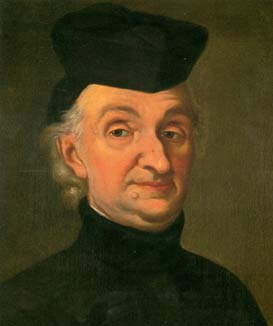Vincenzo Riccati facts for kids
Quick facts for kids
Vincenzo Riccati
|
|
|---|---|

Vincenzo Riccati (1707–1775)
|
|
| Born | 11 January 1707 Castelfranco Veneto, Venetian Republic
|
| Died | 17 January 1775 (aged 68) |
| Nationality | Italian |
| Known for | Hyperbolic functions |
| Scientific career | |
| Fields | Mathematician and physicist |
| Institutions | College of San Francesco Saverio, Bologna Pontifical Gregorian University |
| Academic advisors | Jacopo Riccati |
| Notable students | Gian Francesco Malfatti |
| Notes | |
|
He is the son of Jacopo Riccati and the brother of Giordano Riccati.
|
|
Vincenzo Riccati (born January 11, 1707, in Castelfranco Veneto – died January 17, 1775, in Treviso) was an Italian Catholic priest, a brilliant mathematician, and a physicist. He came from the Republic of Venice.
Who Was Vincenzo Riccati?
Vincenzo Riccati was the second son of Jacopo Riccati, who was also a famous mathematician. Vincenzo was also the brother of Giordano Riccati. On December 20, 1726, Vincenzo joined the Society of Jesus, a religious order.
He taught different subjects in schools run by the Order. He taught belles lettres, which means fine arts and literature, in cities like Piacenza (in 1728), Padua (in 1729), and Parma (in 1734). Later, he traveled to Rome to study theology, which is the study of religious faith.
In 1739, Vincenzo Riccati began teaching mathematics at the Collegio di San Francesco Saverio in Bologna. He taught there for thirty years! He was also one of the first people to join the Italian National Academy of Sciences.
What Did He Study?
Vincenzo Riccati continued the important work of his father, Jacopo Riccati. He focused mainly on mathematical analysis. This field of math deals with how things change and move.
He did a lot of research on differential equations, which are special equations that describe how quantities change. He also worked on physics, which is the study of matter and energy.
In 1757, he published the first part of his book, Opusculorum ad res physicas et mathematicas pertinentium. In this book, he introduced hyperbolic functions. These are special mathematical functions that are similar to regular trigonometric functions (like sine and cosine) but are used with hyperbolas instead of circles. The second part of his book came out in 1762.
Vincenzo Riccati also worked with Hieronymo Saldino on another important book called Institutiones Analyticae. The first part was published in 1765, and the second part in 1767.
He also wrote a book called Dialogo, dove ne' congressi di più giornate delle forze vive e dell'azioni delle forze morte si tien discorso, which was published in Bologna in 1749.
See Also
 In Spanish: Vincenzo Riccati para niños
In Spanish: Vincenzo Riccati para niños
- Girolamo Saladini
- List of Roman Catholic scientist-clerics
Images for kids


